THE
BIOGEOGRAPHER
Newsletter of the Biogeography Specialty Group
of the Association of American Geographers
Electronic Version Volume 5 No. 2 Spring 2005
BSG Board: John Kupfer (President) LesleyRigg, Joy
Wolf, Mary Ann Cunningham, and David Cairns
Ex officio: Taly Drezner (Secretary-Treasurer), Duane Griffin
(Editor).
In this issue:
President's Column
Confessions of a Generalist Living in a Specialists’
World
Every now and then, it’s worth taking stock of one's own research
interests and activities, including not only our current interests but
how our research focus has changed through time, how our activities
form a “consistent” research program (if it all), and how our work fits
into the scientific and societal circles within which we participate.
Many of us, for example, were careful to identify the broader relevance
or significance of our dissertation research as we completed graduate
school and hit the job trail. Those of us who are faculty members also
have to do so when we come up for tenure or promotion and are asked to
characterize the central nature or focus of our research activities.
Several things in the past few months have caused me to once again
reflect on my own body of research, and I’ve come to the conclusion
that: “I’m a weed!”. OK, I’m not a weed in the agricultural sense of
the word, but rather a weed in the sense of being a generalist in what
is increasingly becoming a specialists’ world. This, as I hope to point
out in the next few paragraphs, is not necessarily a bad thing, but
rather one end of the spectrum of approaches to research agendas that
can be seen in biogeography (as in other fields) today.
One of the main reasons I’ve been thinking about the nature of my
research is that I applied and interviewed for a position at the Univ.
of South Carolina this past fall, the first time I had done either
since before coming to Arizona. In my earlier job interviews, I was
relatively fresh out of grad school and one of my main objectives was
to show that my work wasn’t so overly specialized as to remove me from
consideration for jobs that didn’t seem to be quite up my alley. As I
put together my application packet last Fall, assembled my job talk,
and thought about things to emphasize on my trip to Columbia, I had
just the opposite experience. In fact, I came to the realization that I
would likely be the most generalized candidate they would interview for
the position. After all, I’ve worked on riparian ecology in the Midwest
and Southeast, montane forest pattern and process in Tennessee,
Arizona, New Mexico and Idaho, invasive species and fire in Arizona
grasslands, and successional dynamics in landscapes in the Midwest,
Southeast and Central America (plus a few other things to boot). I’ve
published on climate change, succession, seed dispersal, remote sensing
techniques, forest fragmentation and a handful of other topics since
starting graduate school 16 years ago, and my work has been by turns
theoretical, conceptual and applied.
The second thing that had me thinking about my place in the
biogeographic universe was looking through the diversity and sheer
number (39!) of BSG sponsored or co-sponsored sessions for the Denver
AAG meeting. Sixteen of those sessions have the roots “Dendro-” or
“Paleo-” in their titles, and we now have full- or even
multiple-sessions on topics like “Landscape Pathology”, “Stable Isotope
Analysis” and “Hurricanes”. I say this certainly not to imply it’s a
bad thing, but rather because it reminds me of the increasingly
specialized nature of our group’s membership. With respect to myself,
I’m basically a field-based community / landscape ecologist, but I know
a little dendrochronology, a fair amount of remote sensing, a pretty
good amount of geospatial analysis, some ecological modeling, and even
a little bit about pack rats. When people are putting together research
teams for large multidisciplinary projects here at the UA, one of my
problems is not having enough of a distinct niche to fill since I’m not
“the remote sensing guy” or “the dendrochronologist” or “the GIS guy”
(there doesn’t seem to be a call for “the ordination guy”, for example).
So, given the inefficiencies of being a generalist (and there are
several), what is it that drives me to keep doing new and slightly
different things? Over the last few months, I’ve found three answers to
this question, the first of which is simply expediency. Wherever you
go, greater proximity to study sites in the local geographic area for
both me and my students means developing new research questions
appropriate to the region. If you move to a lot of new places (and
ecosystems) like I have, you pick up interests just from being there.
In some cases, this might just involve tweaking pre-existing research
projects or interests (e.g., transferring my interests in Midwestern
floodplain forests to southern bottomland hardwood forests after moving
from Iowa to Memphis); in others, it means developing entirely new
interests (e.g., working in montane forest communities in the Smokies
and Rockies).
Second, when you move as much as I have, you not only expand your
research interests with the proximity to new ecosystems and research
sites but also with greater exposure to new people both inside and
outside of the university. This has certainly been the case, for
example, with the grassland research that I’ve been doing in southern
Arizona for almost 4 years now, which stemmed from interactions with
new colleagues here at UA and the Audubon Society. I never set out to
be a grassland ecologist, but the opportunities to study invasive
species effects and grassland species dynamics using manipulative,
controlled experiments (and seeing the results unfold over a few years)
has allowed me to address some of the same questions I’ve been working
on with trees. Similarly, my interactions with people at Arizona like
Andrew Comrie, Gordon Mulligan, Tom Swetnam, Julio Betancourt, Guy
McPherson and many others on the UA campus have gotten me interested in
topics well outside the scope of my previous research and exposed me to
ideas and methods that I’ll take with me when I move to Columbia this
summer.
Finally, part of the answer is that it’s just my basic personality
type to be interested in a broad range of topics and research
activities. As geographers, I think most of us are inclined to have
some generalist tendencies anyway, but I’ve found that my broad range
of experiences has given me different spins on projects than I would
otherwise have had. In my case, I’ve valued the broad range of
experiences that I’ve had while working on projects with not only other
geographers but also with the range of ecologists, botanists, resource
managers, engineers and geoscientists with whom I’ve worked.
When I was at Memphis, an incoming chair of the Biology Department
told one of my friends that his work was “too broadly focused” and that
to really accomplish something meaningful, he needed to “pick one topic
and focus all his efforts on it”. I remember a subsequent comment from
the Chair that went something like this: “Take me, I study the behavior
of voles so every time I see some new and interesting research, I’m
thinking, ‘How can this relate to voles?’.” I see his point and the
many tangible benefits of being more highly specialized, but I also
have come to understand the occasional value of having broad research
interests as well. All of this I guess brings me to the conclusion that
“I’m OK with being a generalist.” It’s not that being a generalist
means I don’t have a central theme to my work (which “stresses the
manners by which spatial patterns of ecological phenomena interact with
and constrain ecological processes such as succession, plant dispersal
or non-native species invasions”, according to the cover letter of my
USC application), but rather that I enjoy and benefit in some ways from
the breadth of projects that I work on around this central theme. In
this respect, I think I’m a lot like Norm Christensen, Peter White and
others who have influenced my scientific and professional thinking.
Finally, there is a third reason I’ve been thinking about these
things. For the upcoming Denver AAG Meeting, Tony Stallins and George
Malanson have put together a panel with Katrina Moser, David Cairns,
Amy Hessl, Al Parker, Jake Bendix, Tom Crawford and Tom Vale on
“Unifying Themes in Biogeography”. Among the tentative list of topics
to be discussed are: What are the themes in your research of
interest/relevance to the broader biogeographical community? How
important is it to have conversations about unifying themes? Should we
ask more epistemological/philosophical questions about our research?
I’d like to close by encouraging you to make this panel discussion if
it fits into your schedule as I think it will stimulate further
discussion on some of the points I’ve made in my final chair’s column.
Election
BSG Board: Vote Now!
Current
BSG members may vote for President and 2 Board Members. Student
members can also vote for the Graduate Student Board Member. Vote
by sending
an e-mail with your choices to bsg-election05@geog.tamu.edu)
before March 31 . Only current
BSG members are eligible to vote. If you are unable to vote via e-mail,
please send your votes by regular mail to:
David M. Cairns
Department of Geography
3147 TAMU
Texas A&M University
College Station, TX 77845
BSG
Board (Vote for 2)
David
R. Butler (Ph.D. University of Kansas, M.S. University of Nebraska,
B.A. University of Nebraska at Omaha) is Professor and Graduate Program
Coordinator in the Department of Geography at Texas State
University-San Marcos. He is interested in ecotones, and the
interface between biogeography and geomorphology. He is author of
the book (Cambridge, 1995) Zoogeomorphology - Animals as Geomorphic
Agents. He has guest edited special issues of Physical
Geography on the topics of alpine treeline (1994) and
environmental change (2001), served on the editorial boards of Landscape
Ecology (1999-2003) and Physical Geography (1996-present),
and has published 25 book chapters, and over 125 refereed papers in
journals and conference proceedings, including Annals of the
Association of American Geographers, The Professional Geography,
Physical Geography, Progress in Physical Geography, Catena, Arctic and
Alpine Research, and others. He serves on the AAG's
Publications Committee, served as Chair of the AAG Mountain Geography
and Geomorphology Specialty Groups, and was the recipient of the
Mountain Geography group's Outstanding Recent Accomplishment Award
(2001) and the Geomorphology group's G.K. Gilbert Award for Excellence
in Geomorphological Research. He teaches courses in Landscape
Biogeography, Geomorphology, and Research Design.
Charles Lafon (Ph.D. and M.S, University of
Tennessee; B.A., Emory & Henry College) is an Assistant Professor
of Geography at Texas A&M University, where he teaches courses in
biogeography, climatology, field geography, and introductory physical
geography. His research employs fieldwork (including
dendrochronology) and simulation modeling to investigate the effects of
fire, ice storms, insect outbreaks, and historic human land use on
patterns of tree species composition and diversity in eastern North
America. He is also interested in the interactions of terrain,
climate, and vegetation that generate spatial patterns in the frequency
and severity of disturbance. He has served the BSG as a judge in
the student research proposal competition, and has published papers in
the Journal of Vegetation Science, Oikos, Physical
Geography, Climate Research, the Journal of Geography,
and Dendrochronologia.
J. Anthony (Tony) Stallins, (PhD University
of Georgia, MS Georgia State University, BS Florida State University)
has been an Assistant Professor of Geography at Florida State
University for the past five years. His research examines how
coastal and riparian biogeomorphic interactions influence vegetation
patterns and how land-use history influences present-day forest
dynamics. His main research locations have been in the
southeastern US, from salt marshes and barrier island dunes, to
longleaf pine sandhills and cypress-tupelo forests. From a disciplinary
standpoint, Tony is interested in how AAG biogeographers can find
common ground among methodological strands that emphasize field-based
description, hypothesis testing, simulation, and reconceptualization of
pattern and process. Tony teaches courses in Environmental
Science, Map Analysis, Physical Geography, and Field Methods. His
publications have appeared in Plant Ecology, Physical
Geography, the Annals, Climatic Change, and Natural
Areas Journal.
Thomas W. Gillespie (Ph.D. University of
California Los Angeles, M.A. California State University, Chico, B.A.
University of Colorado, Boulder) is a sixth year assistant Professor in
the Department of Geography at UCLA. His research interests over
the last six years have focused on testing biogeographic hypotheses
related to patterns of species richness and rarity for a number of taxa
at local, regional, and global spatial scales. . His research focuses
on three primary themes: forest ecosystems, biogeography and
conservation theories, and geographic information systems and remote
sensing. Currently, his research has been in tropical dry forests of
Oceania which have been identified as high priority areas for
conservation. He has published in Ecological Applications,
International Journal of Remote Sensing, Global Ecology and
Biogeography, Journal of Biogeography, Progress in Physical Geography, and
Conservation Biology.
Robert Dull (Ph.D. University of
California, Berkeley, M.A. San Francisco State University, B.A.
University of California, Santa Barbara) is an Assistant Professor in
the Department of Geography and the Environment at the University of
Texas, Austin (beginning in fall 2004). Prior to joining the
faculty at UT, Rob spent two years (2002-2004) as an Assistant
Professor at Texas A&M University. He has carried out
research projects both in Central America (El Salvador, Nicaragua) and
the western United States focusing on decadal to millennial-scale
changes in regional vegetation, climate, fire regimes, and land
use. Over the past year Rob has been working on late Holocene
paleoecology and modern forest conservation in Nicaragua (Ometepe
Island, Volcán Mombacho, Rivas), as well as starting new
projects along the Gulf Coast of Texas and Mexico (Veracruz,
Tamaulipas). In addition to intro-level physical geography, Rob teaches
upper division and grad classes in Quaternary paleoecology,
biogeography, natural hazards, and human impacts on the
environment. He has published articles in the Journal of
Biogeography, the Journal of Paleolimnology, Latin
American Antiquity, Geological Society of America Special Papers,
and Quaternary Research.
Amy Hessl (Ph.D. University of Arizona,
M.S. University of Wyoming, B.S. & B.A. University of California,
Berkeley) is an Assistant Professor in the Department of Geology and
Geography at West Virginia University. She is interested in the
interaction between ecosystem processes and human activities in
forested systems. She has explored aspen forest dynamics in
Wyoming, paleo-fire regimes in central Washington and carbon dynamics
in eastern deciduous forests of West Virginia. Amy teaches
courses in Physical Geography, Biogeography, Environmental Field
Geography and the Geography of Fire. She has published in BioScience,
Climatic Change, Ecological Applications, and Journal
of Biogeography, among others. As a board member, Amy is
particularly interested in broadening the scope and influence of the
BSG within and beyond the AAG.
David Goldblum (Ph.D. University
of Colorado, M.S. University of Colorado, B.A. University of
California, Los Angeles) is an Associate Professor in the Department of
Geography and Geology at University of Wisconsin-Whitewater. He is
interested in the potential impact of climate change on forest dynamics
at the ecotone between deciduous forest and boreal forest in the
eastern United States. He has been conducting research on this
question in Ontario, Canada since 1999. Previous projects have
been conducted in Australia, New Caledonia, Colorado, and New York
State. David teaches courses in Biogeography, Forest Geography, Spatial
Analysis, and Human-Environmental Problems. He has published in Physical
Geography, Journal of Vegetation Science, Australian Journal of
Ecology, Journal of Biogeography, Bulletin of the Torrey Botanical
Society, and Plant
Ecology.
Jim Speer (Ph.D., University of Tennessee;
M.S., and B.S. University of Arizona) is an Assistant Professor at
Indiana State University. He specializes in Dendrochronology and
examines disturbance ecology. The recent Brood X emergence of
periodical cicadas provided an opportunity to examine cicada ecology
and how they influence succession through their effect on the
trees. He continues to expand the application of dendrochronology
to new insects, tropical regions, and new methods (such as mast
reconstruction). He has organized the North American
Dendroecological Fieldweeks for three years and has helped to organize
the dendrochronology session at AAG for the past five year. Jim
teaches a wide range of classes including Biogeography, Conservation of
Natural Resources, Quaternary Environments, Soil Genesis and
Classification, Structural Geology, and Fundamentals of Tree-Ring
Research. He has published in Ecology, Climate Research, The
Holocene, Journal of Biogeography, and Tree Ring Research.
Valery J. Terwilliger (Postdocs:
University of California, Santa Barbara; Hebrew University, Givat Ram,
Ph. D. University of California, Los Angeles, M.S. University of
Florida, B.A. McDaniel College) is an Associate Professor at the
University of Kansas. Her interests in the relationships between the
responses of plants to their environments and plant distributions are
both quaternary and present-day. She and her students' recent field
research sites include Utah, Arizona, Kansas, Maryland, Panamá,
and Ethiopia. There is also a lab rat component to her work as stable
isotope methods yield many of the insights for her studies. She teaches
honors courses in Physical Geography, and Human Biogeography, as well
as courses and seminars in Plant Geography, Field Ecology, and Stable
Isotopes in the Natural Sciences. Journals that have published her and
her student's papers include Biotropica, Bulletin of the
Geological Society of America, Geochimica et Cosmochimica Acta, Catena,
Earth Surface Processes and Landforms, Vegetatio, New Phytologist,
Earth Science and Planetary Letters, Journal of Plant Physiology,
International Journal of Plant Sciences, International Journal of
Vegetation Science, Progress in Physical Geography, Phytochemistry,
Physical Geography, and American Journal of Botany.
Graduate Student Board
Member (Student BSG Members Vote for 1)
Christopher Gentry (M.A. Indiana State
University, B.A. Indiana University-Southeast) is a Ph.D. student in
the Department of Geography at Indiana University, Bloomington.
At IU he has taught the lecture and laboratory portions of Physical
Systems of the Environment, discussion sections of Introduction
to Human Geography, and has given guest lectures at the School for
Public and Environmental Affairs. His research interests include
dendroecology, landscape and fire ecology, and biogeography. He
is currently researching the effects of changing atmospheric carbon
concentrations and climatic effects on a mixed deciduous hardwood
forest in Indiana. For the past two years he has assisted the
North American Dendroecological Fieldweek and has been a reviewer for Forest
Ecology and Management. He is a regular attendee of BSG
meetings, and a member of the Association for Fire Ecology and Gamma
Theta Upsilon.
Chad Lane (Ph.D. in progress, M.S.
University of Tennessee, B.S. University of Denver) is a Ph.D. student
in the Department of Geography at the University of Tennessee. He
is interested in lake sediment records of the interactions between
climate, vegetation, and human populations throughout the
Quaternary. His main research areas have been the Dominican
Republic and Costa Rica. In his research he uses multiple proxies
to develop detailed records of paleoenvironmental change. In
particular, he uses fossil pollen, charcoal, stable isotope, and other
geochemical analyses to develop these records. Chad’s current
research is focused on identifying the impacts of droughts in the
circum-Caribbean region on both ecological communities and prehistoric
human populations in the interior of the Dominican Republic during the
late Holocene. His past research has included stable carbon
isotope analyses of lake sediments from several lakes in Costa Rica to
identify prehistoric forest clearance and agriculture, natural changes
in vegetation in response to climate change, and changes in
paleolimnological conditions. Chad has published papers in the Journal
of Paleolimnology and has recent submissions to Palynology
and Ecography. During his residence at the University of
Tennessee, Chad has been appointed as a research assistant, a teaching
assistant, and has taught an introductory physical geography course.
President (Vote for 1)
Joy
Nystrom Mast (Ph.D. and M.S. University of Colorado - Boulder,
B.S. University of Wisconsin - Madison) is Chair of the Department of
Geography and Director of the Dendroecology Lab at Carthage College in
Wisconsin. She is interested in forest dynamics of conifer and riparian
ecosystems, focusing on the American Southwest and Rocky
Mountains. Joy currently serves on the National Science
Foundation Geography and Regional Sciences panel and is a consultant
for the National Park Service Southern Colorado Plateau Network for 14
National Parks. She has enjoyed serving the BSG as a executive board
member, as a grant reviewer, and as a student presentation judge, and
is also active in the International Biogeography Society. Joy teaches
courses in Forest Ecology, Biogeography, Biological Conservation, and
field courses in Arizona and Wisconsin. She has received funding for
her research from NSF Biocomplexity program, the National Park Service,
the National Forest Service, the Bureau of Land Management, among
others. Joy has published in a variety of journals and books,
including Journal of Biogeography, Landscape Ecology,
Ecological Applications, Forest Ecology and Management, Canadian
Journal of Forest Research, Physical Geography, and Journal
of Forestry.
Kimberly E. Medley (Ph.D., M.A., Michigan
State University, B.S. Kent State University).
After a one-year postdoctoral appointment in landscape ecology at the
Institute of Ecosystem Studies, Kim began an academic career at Miami
University (in Ohio), where she just received word that she will be
promoted to Professor of Geography. Under a Worldwide
Women-in-Development fellowship in 1997-1998, she worked as an
ecological monitoring and gender specialist for the U.S. Agency for
International Development in Madagascar. Kim is especially interested
in forest resources and how the physical environment and human
activities influence their geographic patterns of diversity,
environmental histories, and conservation futures. She is the
author of over twenty publications in peer-reviewed journals and books,
and especially enjoys her collaboration with graduate and undergraduate
students on integrative and applied research in Ohio, Kenya, and other
locations. Funded by the National Geographic Society and now
Conservation International, she is conducting an ethnoecological
research project on Mt. Kasigau, Kenya that examines the use of woody
plants by the Kasigau Taita along an altitudinal gradient between
bushland and montane evergreen forest. She is grateful for the
professional support provided by colleagues in the Biogeography
Specialty Group and will hope to carry on that tradition for new and
continuing members.
Back to the top.
News
International Biogeography Society News
The 2005 International Biogeography Society conference met Jan. 5-9,
2005 at the National Conservation Training Center, Shepherdstown WV.
The meeting included poster sessions, symposia, a keynote address
and a workshop on Historical Biogeography. The meeting's theme
"Conservation Biogeography," reflects the fact that conservation is
emerging as one of the dominant themes in the IBS and the broader field
of biogeography. As part of this this trend, Blackwell is "rebranding"
one of the Journal of Biogeography's
sister journals as Diversity and
Distributions, a Journal of Conservation Biogeography. The
journal recently published an article by Robert J. Whittaker and other
members of the Oxford University School of Geography's Biodiversity Research Group's article called "Conservation
Biogeography: Assessment and Prospect" (Diversity
and Distributions Vol.
11, Jan. 2005), which BSG members
should find interesting.
The IBS meeting was organized around the five symposia:
- Biogeographic Responses to Global Change
- Biogeography of Exotic Species
- Geography of Parasites and Infectious Diseases
- Geography of Extinction: From Paleo to Recent Periods
- Biogeography and Ecological Impacts of Human Civilizations.
Each symposium included half-hour presentations by five invited
speakers representing the breadth of
the biogeographical enterprise. Brief descriptions of each symposium
and Richard Field's reflections on the meeting are
available in the IBS newsletter (click here).
Poster sessions supplemented the symposia and highlighted the work
of 120 biogeographers. The meeting culminated with
geographer-turned-librarian and Alfred Russel Wallace scholar Charles
Smith's keynote address on Wallace.
The small size of the meeting (around 100 participants, I'm guessing) and intimate
setting encouraged informal discussions, as did the fact that the posters remained
up for a full day. This meant there was plenty of opportunity and time to read
most, if not all, of the posters and to think about them, discuss them during
breaks, meals, or other downtime, and go back and view them multiple times,
if you wanted to. I've never been to a meeting where I discussed the content
of presentations (my own and other peoples') as frequently or in as much depth
and detail as I did at this one. As was the case with the inaugural IBS meeting
2003, I came away from the conference excited about the discipline of biogeography
and full of new ideas and insights. If there were any way we could create this
level of interaction at AAG meetings, I would lobby for moving heaven and Earth
to make it happen.
One of the high points of the symposia was Hartmut Walter's presentation. Hart
is one of the founding members of the BSG, and one of four biogeographers
in the UCLA geography department (along with ex-BSG president and IBS founding
treasurer Glen MacDonald, Tom Gillespe, and Jared Diamond), and his presentation
generated a great deal of interest and discussion. The abstract of Hart's paper
is reproduced below.
To help further its goal of becoming a truly international society, the next
IBS meeting, scheduled for early January 2007, will move beyond the U.S., to
Oxford, U.K. Membership in the IBS is $40 (Students $30), which includes the
IBS newsletter, discounts on IBS meetings and publications, and eligibility
for a $30 subscription to the online versions of the Journal of Biogeography,
Global Ecology & Biogeography, and Diversity & Distributions
(a personal subscription is $330, so this is a steal!). For more information,
see the IBS web site.
The
Culture and Politics of Extinction: A Geography of Human Folly and Animal Angst
Hartmut S. Walter
UCLA
2nd Biennial Conference, International Biogeography Society, Shepherdstown,
West Virginia, January 5-9, 2005.
The current distribution of biota is a product of a complex of interactive
historic and present-day factors; some of these are anthropogenic in nature.
This paper investigates the contribution of human behavior, beliefs, and policies
that contribute to extinction processes in animals. I am particularly interested
in those cases where incorrect or ecological and geographic assessments of rarity
and extinction probability result in faulty or inefficient conservation management.
It is hoped that biogeography can address this problem by recognizing and incorporating
the complex human-animal interface into future conservation science and management.
One aspect concerns the need to create a firewall between distributional reality
and the partisan needs of motivated stakeholders. Biogeography cannot afford
to support trivial conservation demands when there is an abundance of unmet
and poorly understood conservation needs among noncharismatic taxa around the
world.
Department News
Biogeomorphology at Kentucky
Several members of the University of Kentucky Department of
Geography are involved in projects examining the coevolution of
landforms, soils, and ecosystems, and the effects of trees on
weathering and regolith evolution, in forest environments in the
Ouachita Mountains, Arkansas. Jonathan Phillips (Professor) and Dan
Marion (USDA Forest Service, Southern Research Station, and Adjunct
Professor of Geography) have been examining the biomechanical effects
of trees on soil variability and regolith evolution, and the relative
importance of biological and lithological influences. Publications on
this work, funded by the USDA Forest Service, have appeared or are in
press in Geoderma, Forest Ecology & Management, Earth Surface
Processes & Landforms, and Journal of Geology. Kristin Adams
recently completed her M.A. thesis in conjunction with this work, and a
number of other Kentucky geography faculty and graduate students, and
Forest Service personnel, have contributed to this ongoing work. The
newest phase of the project is examining in detail the effects of tree
roots on weathering at the bedrock weathering front, with Assistant
Professor Alice Turkington playing a key role. PhD candidate Linda
Martin, in addition to assisting in the Arkansas work, is pursuing her
dissertation (funded by EPA) on evolution of fluviokarst landscapes in
central Kentucky, with the hydrologic and geomorphic effects of trees,
and root-rock interactions at the base of the epikarst, playing a
central role.
Jonathan D. Phillips
New Disciples of Soil
Lexington, Kentucky
(Univ. of Kentucky, Dept. of Geography)
http://ukslsrp.150m.com/JPhome.htm
Member News
Henri Grissino-Mayer
Henri's involvement with the "the mystery of the Messiah," (see here, and here) has launched something of a cottage
industry in forensic biogeography. In the last issue, we highlighted his work
on the (putative) Abraham Lincoln log cabin. Since then, he's
been involved in three more projects, dating the Karr-Koussevitzky 1611 Amati
bass, working on a Texas murder case (see Research Notes below), and dating
another historic cabin. The latter project, Henri promises, "will actually help
re-write Tennessee history and history books." We'll feature it in the next
issue.
Henri on (1611 Amati) Bass
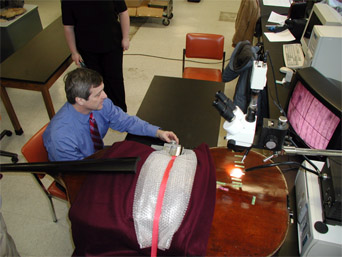 The performances and conducting of Serge Koussevitzky
(1874-1951) gave the world its first serious exposure to the double
bass instrument. In 1962, after hearing a New York Town Hall recital
given by Gary Karr, Koussevitzky's widow, Olga, gave Karr the double
bass used by Serge Koussevitzky, reportedly made by Antonio and
Hieronymous Amati in 1611. The Amati brothers were sons of Andrea Amati
who began the famed Amati line of instrument makers in Cremona, Italy,
in the mid to late 1500s. Nicolo Amati (1596-1684), the son of
Hieronymus, was the mentor of Antonio Stradivari.
The performances and conducting of Serge Koussevitzky
(1874-1951) gave the world its first serious exposure to the double
bass instrument. In 1962, after hearing a New York Town Hall recital
given by Gary Karr, Koussevitzky's widow, Olga, gave Karr the double
bass used by Serge Koussevitzky, reportedly made by Antonio and
Hieronymous Amati in 1611. The Amati brothers were sons of Andrea Amati
who began the famed Amati line of instrument makers in Cremona, Italy,
in the mid to late 1500s. Nicolo Amati (1596-1684), the son of
Hieronymus, was the mentor of Antonio Stradivari.
Today, Gary Karr has been acclaimed as "the world's leading solo
bassist" by Time Magazine, and is considered the first solo double
bassist in history to make playing a full-time career. In 1967, Karr
founded the International Society of Bassists (ISB). In 2004, Karr
stunned the music world by donating the Karr-Koussevitzky 1611 Amati
bass to the ISB, and plans have been made for leading artists to
perform with it at the 2005 ISB Convention in Michigan.
However, close inspection by a top team of experts found stylistic
inconsistencies with the double bass, including the purfling, the top
C-bout channel, the F-holes, and the varnish. Furthermore, the shape of
the instrument itself appears to have been influenced by Stradivari,
who would not be born for another 33 years. The experts reported their
findings to Madeleine Crouch, President of the ISB, who had previously
heard that tree-ring dating had helped solve the mystery of the
"Messiah" violin.
The ISB contacted Henri Grissino-Mayer, and on January 28 and 29,
the Karr-Koussevitzky bass was analyzed in the Laboratory of Tree-Ring
Science at the University of Tennessee. Surprisingly, the double bass
had a continuous series of 297 tree rings on both sides of the
instrument, the most tree rings ever found in a musical instrument,
suggesting the instrument was indeed made in Europe. Dr. Grissino-Mayer
is now comparing the patterns of the tree rings from this instrument
with reference spruce chronologies from the upper elevations of Italian
and Austrian Alps region, the most likely locality of the wood used to
make the instrument.
Henri reports that he does have absolute dates for the tree rings in
the instrument, but has been requested not to release the dates just
yet. If the instrument was indeed made by the Amati brothers in 1611,
the instrument would be priceless because this would be the only double
bass known to have been constructed by the Amati brothers.
Also, Henri, Sally Horn, and Ken Orvis
currently have research featured in an exhibit called "Lost
Worlds: Discovering Past Environments" at the University of
Tennesee's McClung Museum.
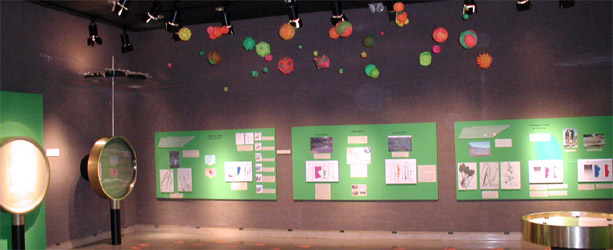
Back to the top.
AAG
Biogeographers in Denver
Biogeography Specialty Group Business
Meeting
The BSG business meeting is scheduled for Thursday (4/7/05) from 11:50 AM -
12:50 PM. Bring a lunch and join us.
Physical Geography Reception
A Physical Geography Reception will be held 8-11
PM on
Friday April 8, in the Majestic Ballroom of the Adam’s Mark Hotel. The
reception will feature remarks by AAG Vice-President Dick Marston,
displays by
several publishing houses, and complementary food and drinks. All AAG
members
specializing in an aspect of physical geography (and a guest) are
welcome at
the event. There is no admission charge.
The reception is sponsored by the AAG’s
Cryosphere, Geomorphology,
Climate, Mountain Geography, Biogeography, and Water Resources
Specialty
Groups. In addition to donations by the sponsoring specialty groups,
generous
financial support has been provided by co-sponsors Blackwell Publishing
Inc.,
John Wiley & Sons Ltd., Elsevier Science Ltd., and Bellwether
Publishing
Ltd. A representative from each of these firms will be present, and
books,
journals, and other materials will be on display.
The reception will have two continuous slide shows
running,
similar to the one last year in the “Celebrating a Century of Physical
Geography” reception at the Philadelphia meeting. Reception organizer
Fritz
Nelson requests that physical geographers each send him ONE power
point
slide containing (a) one or more images showing their current research,
and (b)
a one-paragraph annotation or description. Please keep the size
of
individual slides to 6 Mb or less. Send slides to Fritz at recep@geog.udel.edu by March 21. Please ensure that slides are in
final
presentation format—no editing will be done on them.
BSG Sponsored Sessions
This year, we have thirty
BSG-sponsored paper sessions. For details on specific sessions and
papers, go to the AAG's 2005
Annual Meeting Program web page, select "Specialty Group" in the
search criteria, and search on "biogeography."
- Advances in Paleoclimatology I, II, and III: Quantitative,
multiproxy, and novel approaches to climate reconstruction
- Biogeography Illustrated Paper Session
- Dendroclimatology I and II
- Dendroecology
- Dendroecology and Disturbance
- Dendrogeomorphology
- Eastern Forest Dynamics
- Emerging themes in political ecology III: Changing landscapes
and biogeographies
- Exotic Species Invasion Dynamics
- Fire History from Dendrochronology
- Geographic approaches to understanding urbanising landscapes and
urban ecosystems
- Geographic approaches to understanding urbanising landscapes and
urban ecosystems
- Geosystems, Ecosystems, and Wildfires 1: Geomorphic Hazards
- Geosystems, Ecosystems, and Wildfires 2: Soil Factors and Time
- Geosystems, Ecosystems and Wildfires 3: Remote Sensing
Applications to Fire Hazard and Effects Assessment
- Geosystems, Ecosystems, and Wildfires 4: Biotic Effects and
Responses
- Geosystems, Ecosystems, and Wildfires 5: Management Issues
- Hurricanes I: Spatial and Temporal Variability
- Hurricanes II: Paleotempestology
- Hurricanes III: Landfalling Hurricanes and Societal Impacts
- Integrative Dendrochronology: Theoretical Cross-overs to Other
Disciplines
- Landscape Pathology
- Landsurface - Atmosphere Interactions I
- Landsurface - Atmosphere Interactions II and Urban Climate I
- Paleobiogeography I: Pollen and Charcoal Calibration and Analysis
to Reconstruct Fire, Vegetation and Agricultural History
- Paleobiogeography II: Paleo Records of Climate, Geomorphic, and
Vegetation Change from the American and African Tropics
- Paleobiogeography III: Paleoecological Evidence of Prehistoric
Human Activity in the Circum-Caribbean Region
- Paleobiogeography IV: Late Quaternary Climate and Vegetation
Change in Temperate North America
- Prehistory, Geoarchaeology, and Paleobiogeography: prospects for
engagement and synthesis
- Stable isotope analysis of trees: new methods, new uses.
- Tropical rarity: biogeography of endemism in low latitude
environments
- Unifying themes and issues in AAG Biogeography Panel Discussion
- Unifying themes and issues in AAG Biogeography I and II
- Western Forest Dynamics
Field Trips!
Click
here for more information on these and other field trips.
A
Landscape Transect in the Boulder Valley Tuesday, April 5: 8am
– 4pm Organizer/Leader: Paul W. Lander, City of Boulder/University of
Colorado Trip Capacity: 40 Cost/person: $75 (includes transportation,
lunch and handouts)
Rocky
Mountain National Park Thursday, April 7: 7am – 6pm
Organizer/Instructor: William C. Rense Workshop Capacity: 40
Cost/person: $75 (includes transportation, lunch, admission fees and
handouts)
Fire and
Forest Management in the Colorado Front Range Friday, April
8: 8am – 6:30pm Organizer/Leader: Rosemary Sherriff,
University of Colorado – Boulder; Thomas Veblen,
University of Colorado - Boulder Trip Capacity: 32 Cost/person: $70
(includes transportation, lunch and handouts)
Terrestrial
Paleoenvironments of the Front Range Near Denver, Colorado
Friday, April 8: 9am – 5pm Organizer/Leader: Joanna Wright, University
of Colorado - Denver Trip Capacity: 40 Cost/person: $70 (includes
transportation, lunch and handouts).
Back to the top.
Recent BSG Member Publications.
Name in bold is the individual submitting
publications.
Meral Avci
Avci, Meral. 2004. Rhododendrons
and their natural occurences in Turkey. İstanbul Üniversitesi
Edebiyat Fakültesi Coğrafya Dergisi 12: 13-29. (In Turkish, also
English abstract).
Avci, Meral. 2004. The
influence of geographical characteristics on the naming of plants in
Turkey. İstanbul Üniversitesi Edebiyat Fakültesi Coğrafya
Dergisi 12: 31-45. (In Turkish, also English abstract).
Matthew Becker
Bekker, M.F. 2004. Spatial variation in the
response of tree rings to normal faulting during the Hebgen Lake
earthquake, southwestern Montana, USA. Dendrochronologia 22:53-9.
Bekker. M.F. 2005. Positive feedback between
tree establishment and patterns of subalpine forest advancement,
Glacier National Park, Montana, USA. Arctic, Antarctic, and Alpine
Research, in press.
David Butler
Allen, Thomas R., Stephen J. Walsh, David M.
Cairns, Joseph P. Messina, David R. Butler, and George P.
Malanson, 2004. Geostatistics and spatial analysis: characterizing form
and pattern at the alpine treeline. In: GIScience and Mountain
Geomorphology (M.P. Bishop and J.F. Shroder, Jr., eds.), Springer
Verlag - Praxis Scientific Publishing, Heidelberg, Germany, 189-214.
Butler, David R., 2004. Zoogeomorphology. In:
Encyclopedia of Geomorphology, Volume 2 (Andrew Goudie, ed.),
Routledge, London, 1122-1123.
Butler, David R., George P. Malanson, and Lynn
M. Resler, 2004. Turf-banked terrace treads and risers, turf
exfoliation, and possible relationships with advancing treeline. Catena
58(3), 259-274.
Resler, Lynn M., Mark A. Fonstad, and David R.
Butler, 2004. Mapping the alpine treeline ecotone with digital aerial
photography and textural analysis. Geocarto International 19(1), 37-44.
Malanson, George P., David R. Butler, and
Stephen J. Walsh, 2004.Ecological response to global climatic change.
In: WorldMinds: Geographical Perspectives on 100 Problems (Donald G.
Janelle, Barney Warf, and Kathy Hansen, eds.). Kluwer Academic
Publishers, Dordrecht and Boston, 469-473.
Walsh, Stephen J., Daniel J. Weiss, David R.
Butler, and George P. Malanson, 2004. An assessment of snow avalanche
paths and forest dynamics using Ikonos satellite data. Geocarto
International 19(2), 85-93.
Henri Grissino-Mayer
Burckle, Lloyd, and Henri D. Grissino-Mayer.
2003. Stradivari, violins, tree rings, and the Maunder Minimum: a
hypothesis. Dendrochronologia 21(1): 41-45.
Soulé, Peter T., Paul A. Knapp, and Henri D. Grissino-Mayer.
2003. Comparative rates of western juniper afforestation in
south-central Oregon and the role of anthropogenic disturbance.
Professional Geographer 55(1): 43-55.
Grissino-Mayer, Henri D. 2003. Canons for writing and editing
manuscripts. Tree-Ring Research 59(1): 3-10.
Grissino-Mayer, Henri D. 2003. A manual and tutorial for the proper
use of an increment borer. Tree-Ring Research 59(2): 63-79.
Grissino-Mayer, Henri D., William H. Romme, M. Lisa Floyd-Hanna, and
David Hanna. 2004. Climatic and human influences on fire regimes of the
southern San Juan Mountains, Colorado, USA. Ecology 85(6): 1708-1724.
Grissino-Mayer, Henri D., Paul R. Sheppard, and Malcolm K.
Cleaveland. 2004. A dendroarchaeological re-examination of the
“Messiah” violin and other instruments attributed to Antonio
Stradivari. Journal of Archaeological Science 31(2): 167-174.
Huffman, Jean M., William J. Platt, Henri D. Grissino-Mayer, and
Carla J. Boyce. 2004. Fire history of a barrier island slash pine
(Pinus elliottii) savanna. Natural Areas Journal 24(3): 258-268.
Kaennel Dobbertin, Michéle, and Henri D. Grissino-Mayer.
2004. The Bibliography of Dendrochronology and the Glossary of
Dendrochronology: Two new online tools for tree-ring research.
Tree-Ring Research 60(2): 101-104.
Speer, James H., Kenneth H. Orvis, Henri D. Grissino-Mayer, Sally P.
Horn, and Lisa M. Kennedy. 2004. Assessing the dendrochronological
potential of Pinus occidentalis in the Cordillera Central of the
Dominican Republic. Holocene 14(4): 561-567.
Soulé, Peter T., Paul A. Knapp, and Henri D. Grissino-Mayer.
2004. Human agency, environmental drivers, and western juniper
establishment during the late Holocene. Ecological Applications 14(1):
96-112.
Ryan Danby
Danby, R.K. 2003. Birds and mammals of the St.
Elias Mountain Parks: Checklist evidence for a biogeographic
convergence zone. The Canadian Field-Naturalist 117:1-18.
Amy Hessl
Hessl, A. E., McKenzie, D., and Everett, R.
2004. Fire and climatic variability in the inland Pacific
Northwest. Ecological Applications 14(2):425-442.
Hessl, A. E. and D. L. Peterson. 2004. Interannual
variability in aboveground tree growth in Stehekin River watershed,
North Cascade Range, Washington. Northwest Science 78(3): 204-213.
McKenzie, D., S. Prichard, A. E. Hessl, and D.
L. Peterson. 2004. Empirical approaches to modeling wildland fire in
the Pacific Northwest Region of the United States: methods and
applications to landscape simulation. Chapter 7 in A.J. Perera and L.
Buse, eds., Emulating Natural Forest Landscape Disturbances. Columbia
University Press, New York, NY.
Hessl, A. E. 2003. Human interactions with
ecosystem processes: causes of aspen decline in the intermountain West.
In: B. Wharf, D. Janelle and K. Hanson, eds. WorldMinds: Geographical
Perspectives on 100 Problems. Pp. 311-316.
Fagre, D. B., D. L. Peterson and A. E. Hessl. 2003.
Taking the pulse of mountains: ecosystem responses to climatic variability.
Climatic Change 59(1): 263-282.
John Kupfer
Kupfer, J.A. and Miller, J.D. 2005. Wildfire effects
and post-fire responses of an invasive mesquite population: the interactive
importance of grazing and non-native herbaceous species invasion. Journal
of Biogeography 32: 453-466
Kupfer, J.A. and Emerson, C.W. 2005. Remote sensing. In: Encyclopedia of
Social Measurement, Vol. 3. Kempf-Leonard, K. (ed.). Academic Press, San
Diego, pp. 377-383.
Kupfer, J.A. and Malanson, G.P. 2004. The biodiversity crisis. In: WorldMinds:
Geographical Perspectives on 100 Problems. Warf, B., Hansen, K, and Janelle,
D. (eds.). Kluwer Academic Publishers, Dordrecht, pp. 273-277.
Kupfer, J.A, Webbeking, A.L., and Franklin, S.B. 2004. The effects of landscape
structure on plant regeneration patterns and soil characteristics in shifting
cultivation fields near Indian Church, Belize. Agriculture, Ecosystems and
Environment 103: 509518.
Franklin, S.B., Kupfer, J.A., Grubaugh, J.W. and Kennedy, M.L. 2004. A
multi-taxa analysis of biotic diversity in Natchez Trace State Forest, western
Tennessee. Environmental Monitoring and Assessment 93: 31-54.
Franklin, S.B. and Kupfer, J.A. 2004. Forest communities of Natchez Trace
State Forest, western Tennessee Coastal Plain. Castanea 69: 15-29.
Glen MacDonald
Huang, C. MacDonald, G.M. and Cwynar, L.C. 2004.
Holocene landscape development and climatic change in the Low Arctic,
Northwest Territories, Canada. Palaeogeography, Palaeoclimatology,
Palaeoecology 205: 221-234.
Kaufman, D.S., Ager, T.A., Anderson, N.J.,
Anderson, P.M., Andrews, J.T., Bartelein, P.J., Burbaker, L.B., Coats,
L.L., Cwynar, L.C., Duval, M.L., Dyke, A.S., Edwards, M.E., Eiser,
W.R., Gajewski, K., Geisodottir, A., Hu, F.S., Jennings, A.E., Kaplan,
M.R., Kewin, M.W., Lozhkin, A.V., MacDonald, G.M., Miller, G.H., Mock,
C.J., Oswald, W.W., Otto-Blisner, B.L., Porinchu, D.F., Rhland, K.,
Smol, J.P., Steig, E.J., Wolfe, B.B., 2004, Holocene thermal maximum in
the western Arctic (0-180 W). Quaternary Science Reviews 23: 529-560 .
Kremenetski, K. V., Boettger, T., MacDonald, G.
M., Vaschalova, T., Sulerzhitsky, L., Hiller, A. 2004. Medieval climate
warming and aridity as indicated by multiproxy evidence from the Kola
Peninsula, Russia. Palaeogeography, Palaeoclimatology, Palaeoecology
209: 113-125
Kremenetski, K.V., MacDonald, G.M., Gervais,
B.R., Borisova, O.K., Snyder, J.A. 2004. Holocene vegetation history
and climate change on the northern Kola Peninsula, Russia: a case study
from a small tundra lake. Quaternary International 122: 57-68.
Sheng, Y., Smith,L.C., MacDonald,G.M.,
Kremenetski, K.V., Frey, K.E., Velichko, A.A., Lee, M., Beilman, D.W.
and Dubinin, P. 2004. A high-resolution GIS-based inventory of the west
Siberian peat carbon pool. Global Biogeochemical Cycles 18 (GB3004,
doi:10.1029/2003GB002190): 1-14.
Smith, L.C., MacDonald, G.M., Velichko, A.A.,
Beilman, D.W., Borisova, O.K., Frey, K.A., Kremenetski, K.V., and
Sheng, Y. 2004. Siberian peatlands a net carbon sink and global methane
source since the early Holocene. Science 303: 353-356.
Case, R.A. and MacDonald, G.M. 2003. Tree ring
reconstructions of streamflow for three Canadian Prairie rivers.
Journal of the American Water Resources Association 39: 703-716.
Case, R.A. and MacDonald, G.M. 2003.
Dendrochronological analysis of the response of tamarack (Larix
laricina) to climate and larch sawfly (Pristiphora erichsonii)
infestations in central Saskatchewan. Ecosience 10: 380-388.
Kremenetski, K.V., Velichko, A.A., Borisova,
O.K., MacDonald, G.M., Smith, L.C., Frey, K.E. and Orlova, L.A. 2003.
Peatlands of the Western Siberian lowlands: current knowledge on
zonation, carbon content and Late Quaternary History. Quaternary
Science Reviews 22: 703-723.
MacDonald, G., Kaufman, D., Duvall, M, and
Coates, L. 2003. PARCS: Paleoenvironmental Arctic Sciences - taking the
long view. Arctic Research of the United States 17: 50-58.
Joy Mast
Savage, M. and Mast, J.N., 2005. The fate of
ponderosa pine forests decades after intense crown fire. In press,
Canadian Journal of Forest Research.
Mast, J.N. and Wolf, J. 2004. Ecotonal changes
and altered tree spatial patterns in lower mixed-conifer forests, Grand
Canyon National Park, Arizona, U.S.A. Landscape Ecology 19(2): 167-180.
William Noble
The Aftermath of the Pleistocene in the Upper
Nilgiris of Southern India, 2004, Journal, Bombay Natural History
Society 101 (1): 29-63.
The Nilgiri of Tamil Nadu, India, as a
Distinctive Upland Island, pgs. 401-420, in 2004, Neelam Grover and
Kashi Nath Singh (eds.), Cultural Geography: Form and Process, a
festschrift in honor of Prof. A. B. Mukerji, New Delhi, Concept
Publishing Company, xxxiii, 469 pp.
Jonathan Phillips
Phillips, J.D., and D.A. Marion. 2005.
Biomechanical effects, lithological variations, and local pedodiversity
in some forest soils of Arkansas. Geoderma 124: 73-89.
Phillips, J.D. 2004. Divergence, sensitivity,
and nonequilibrium in ecosystems. Geographical Analysis 36: 369-383.
Phillips, J.D., and D.A. Marion. 2004.
Pedological memory in forest soil development. Forest Ecology and
Management 188: 363-380.
Lesley Rigg
Rigg, L.S. (2005) "Disturbance processes in
maquis and forest, and the resulting spatial patterns of two emergent
maquis conifers, New Caledonia" (In Press Austral Ecology)
Rigg, L.S. and S. W. Beatty (2004) "The
abundance and spatial distribution of herbaceous and woody vegetation
along old field margins in three upstate New York fields" The Great
Lakes Geographer. 11(1): 54-65.
Rigg, L.S. (2003) "Genetic Applications in
Biogeography: An introduction." Physical Geography, 24(5): 355-7.
Diochon, A., L.S. Rigg, D. Goldblum, and N.O.
Polans (2003) "The regeneration dynamics and genetic variability of
sugar maple (Acer saccharum [Marsh.]) seedlings at the
species' northern growth limit, Lake Superior Provincial Park, Ontario,
Canada." Physical Geography, 24(5): 399-413.
Susy Zeigler
Ziegler, Susy Svatek. 2004. Composition,
structure, and disturbance history of old-growth and second-growth
forests in Adirondack Park, New York. Physical Geography 25 (2): 152169.
Back to the top.
Research Notes
Lesley Rigg,
Department of Geography, Northern Illinois University.
Biogeography and Beamtime
 In conjunction with Dr. Melissa Lenczewski from the Dept.
of Geology and Environmental Geosciences at Northern Illinois
University, we recently initiated a project in New Caledonia examining
the role of the microbial community in vegetation change and structural
associations. We received funding from the American Association for the
Advancement of Science and the National Science Foundation: Program for
Women in International Scientific Collaboration (great program!).
In conjunction with Dr. Melissa Lenczewski from the Dept.
of Geology and Environmental Geosciences at Northern Illinois
University, we recently initiated a project in New Caledonia examining
the role of the microbial community in vegetation change and structural
associations. We received funding from the American Association for the
Advancement of Science and the National Science Foundation: Program for
Women in International Scientific Collaboration (great program!).
This work built on previous biogeographic research on species in New
Caledonia such as the endemic conifer Araucaria laubenfelsii.
Last year we were granted beamtime at the Advanced Photon Source (APS),
Argonne National Laboratories, to examine the uptake of nickel by Araucaria
laubenfelsii.
Along with a NIU PhD student, Linda Jones, we have now completed out
third set of beamtime (150 hours) and have expanded our research to
examine the uptake, location, and storage of, trace chemicals and
metals in trees growing in contaminated soils in northern Illinois. We
are working with a great team at Argonne (GeoSoilEnviroCARS, Dr. Steve
Sutton and Dr. Matt Newville) and we are currently attempting to
analyze our copious quantities of data!!
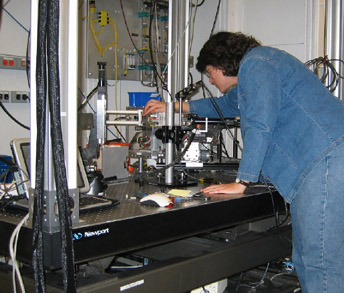 |
 |
| Putting a sample in the hutch. |
Monitoring the results: Linda Jones on the left. |
For more information
http://www.lightsources.org/cms/?pid=1000166#section3
http://www.aps.anl.gov/
http://cars9.uchicago.edu/gsecars/GSEmain.html
Hartmut S. Walter
University of California-Los Angeles
Hart Walter continues to maintain a skeptical view of general and
global concepts in biogeography. He is currently working on regional
case studies that can illustrate the relevance of the geographic place
as part of the ecological niche (termed eigenplace). He is also working
on biogeographic aspects of extinction and presented a plenary paper on
the Culture and Politics of Extinction at the recent biennual symposium
of the International Biogeography Society. Two of his recent papers
reflect his critical analysis of biogeographic paradigms:
Walter, H. S. 2004. Understanding places and organisms in a changing
world. TAXON 53:905-910.
Walter, H. S. 2004. The mismeasure of islands: implications for
biogeographic theory and the conservation of nature. Journal of
Biogeography 31:177-197.
Regionally, he is currently spearheading an ESA petition drive with
UCLA undergraduates to save the endemic, unprotected and tiny remnant
population of the island loggerhead shrike (Lanius ludovicianus
anthonyi) on the northern Channel Islands off Santa Barbara, CA. For
details, see:
Walter, H. S. 2005. Extinction at our doorstep: what happened to the
island loggerhead shrike? Western Tanager 71 (4):1-3.
Henri Grissino-Mayer
University of Tennessee
The Baltimore Sun (February 4, 2005; E1) reported on Henri Grissino-Mayer's
collaboration with ORNL colleague Madhavi Martin to match pieces of wood found
with the body of a homicide victim with others connected with the suspected
killer. Investigators contacted Henri to see if he could match the two sets
of samples based on tree rings. The wood turned out to be mesquite, which doesn't
form good rings, but Henri contacted Madhavi Martin at Oak Ridge, who uses laser-induced
breakdown spectroscopy (LIBS) to identify the geographic origin of imported
wood from Canada. The samples did, indeed match. The suspected killer has already
confessed, but prosecutors may use the evidence when the case goes to trial
later this year.
LIBS has been used to analyze soil
carbon and nitrogen, and may hold great promise for biogeographic research.LIBS
woks by using a high-energy pulsed laser to vaporize small amounts of a bulk
sample and optically excite the constituent elemental species of the resulting
vapor plume, and then recording the time-sensitive ultraviolet-visible emission
spectra of the elements as they de-excite. The result is a ppm-range multielemental
microanalysis of the sample, collected instantaneously with minimal sample loss
and little or no sample preparation. Researchers at Oak Ridge are currently
working to develop a field-deployable unit that could greatly expand opportunities
for biogeochemical research. (See Lesley Riggs' Research Note above).
Meral Avci
Istambul University
Dr. Meral Avci, did a dendrochronological studies in west part of Black Sea
Region (Turkey) that was financially supported by the Research Fund of Istanbul
University (Project number: 1780/21122001). In this research, the air pollution
which effects on annual ring widths of forest trees are tried to be determined
in Catalagzi surrounding (July 2004). Within the scope of this study, tree’s
increment corer samples were obtained from some locations to the south, east,
and west of Catalagzi Thermal Power Plant. She investigated a correlation between
annual ring widths and air pollution; annual ring widths and climatic components.
Width of annual tree rings might decrease because of the air pollution effect
in Catalagzi Thermal Power Plant surrounding, but site characteristics are better
than any place (humidity climate, deep soil etc.). So, this caused the decreasing
of the damage degree.
 |
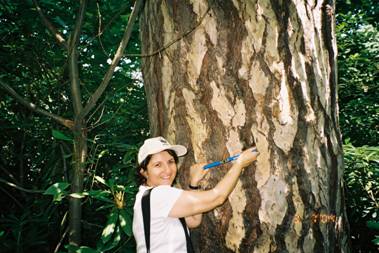
|
|
Catalagzi Thermal Power Plant in west part of
Black Sea Region (North Turkey).
|
Dr. Avci, in Catalagzi |
For more information, contact
Dr. Meral Avci
Istanbul University,
Letters Faculty, Geography Department
Laleli/Istanbul
e-mail: mavci@istanbul.edu.tr
Back to the top.
Field Notes
Saskia van de Gevel and Evan
Larson; Advisor: Henri Grissino-Mayer
University of Tennessee
Whitebark pine (Pinus albicaulis Engelm.)
is a long-lived tree species found in many high elevation and subalpine
forest communities of western North America. Twentieth century fire
suppression, periodic mountain pine beetle outbreaks, and white pine
blister rust infestations have led to dramatic declines in whitebark
pine communities throughout the species’ native range, with critical
ramifications for dependent wildlife species. To better understand the
dynamics of these declining communities, we are investigating (1)
current and past stand dynamics, (2) the role of wildfires and the
effects of its exclusion, and (3) the synergistic effects of various
disturbances and climate in several locations in western Montana.
During a month-long expedition during the 2004
field season, we collected stand and fire history data on three
mountains in the Lolo National Forest, near Missoula, Montana, and on
one peak in the Beaverhead-Deerlodge National Forest along the border
between southwestern Montana and Idaho. Thanks to Elaine
Kennedy-Sutherland, we also attended a workshop on monitoring white
pine blister rust in whitebark pine forests, presented by the Whitebark
Pine Ecosystem Foundation in West Yellowstone. Analyses of our samples
have thus far yielded a 1000-year whitebark pine tree-ring chronology
that dates well against previously-developed whitebark pine
chronologies in Idaho. The fire histories for each mountain include a
combined 150 fire scars and 70 unique fire events over the past 600
years. We have presented our preliminary results at the Whitebark Pine
Ecosystem Foundation Meeting in Waterton, Canada in September of 2004,
and look forward to presenting our recent findings at the Association
of American Geographers Annual Meeting in Denver this April.
This research was
funded in part by the 2004 Biogeography Specialty Group Research Grant
awarded to Evan for his Master’s thesis research. The grant was used
for travel, field equipment, and for several layers to help ward off
the early June weather of the high country. Thank you!
Saskia has been
awarded a National Science Foundation Doctoral Dissertation Research
Improvement Grant to continue her research on whitebark pine stand
dynamics for the next two summers.
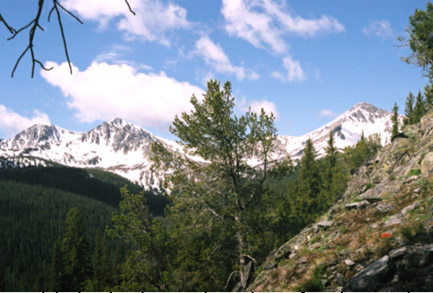 |
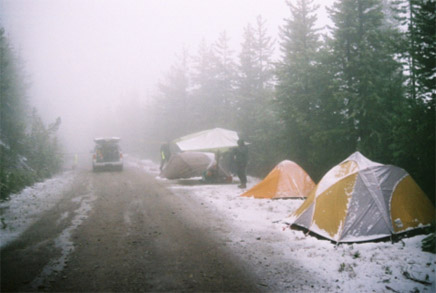 |
| A whitebark pine at the edge of a plot on the
slopes of Ajax Peak, in the Beaverhead-Deerlodge National Forest,
Montana. |
Henri's first day in the field with us began with a soggy camp and whiteout
conditions on top of Point Six, but we still managed to put in a good
day of work! |
Back to the top.
Book Notes
Book Notes highlights recent books written by, or of special
interest to, BSG members. Reviews and suggestions welcome.
Review
Susan Woodward
Biomes
of Earth: Terrestrial, Aquatic, and Human-Dominated.
2004. Greenwood Press. 456 pages, maps, photos, tables. List price: $79.95 (USD).
ISBN: 0-313-31977-4.
and
Lori Daniels
Biogeography
Image Exchange: Explore the World's Biomes
Explore! CD. List price $10.00 (USD).
Anybody who has
ever
considered creating an introductory course on comparative biogeography
has
probably abandoned the idea after searching, and not finding, a
suitable
textbook. There are several biome books and reference volumes aimed at
K-12
students, and more advanced-level volumes devoted to specific biomes,
but there
is no current text devoted solely to comparative biomes and written for
an
undergraduate audience.
Susan Woodward’s Biomes of Earth: Terrestrial, Aquatic, and Human-Dominated
fills this long-standing gap in the physical geography
textbook market with a comprehensive and reasonably priced undergraduate (and
advanced high school) textbook. The book grew out of Woodward’s contribution
to the Virtual Geography
Department which promised, back in the heady early days of the web, to supplant
commercial textbooks by promising free access to constantly up-to-date and massively
hyperlinked online content. Publishers were understandably nervous about such
ventures, but as it turned out, they needn't have worried. The Virtual Department
fizzled, for the most part, but old-fashioned publishing seems to be doing fine.
Fortunately, Greenwood Press has seen fit to "rescue" one of the brighter pieces
of the failed virtual revolution and deliver it to us in the form of a promising
textbook.
Biomes of Earth
is both
predictable and surprising. Predictably, the book consists of an
introduction,
followed by chapters devoted to individual biomes. It is structured in
four
parts, with separate sections for terrestrial, freshwater, marine, and
human-dominated biomes. Each section begins with an overview that
covers basic
concepts and terminology used in the subsequent chapters. Each biome
chapter
follows a standard format that begins with a map and overview, and
includes
subdivisions covers climate, vegetation, soils, animals, and regional
expressions. And like most textbooks Biomes
has key terms set in bold type and defined in a glossary, is sprinkled
with (black
and white) photographs, is indexed, and includes a bibliography. Given
the
finite limits of a single introductory textbook, the coverage is
predictably
broad and shallow.
These are not weaknesses. Lack of depth is unavoidable
given Woodward’s goal of creating a comprehensive introductory textbook
on an immensely broad, diverse, and complex topic. The book’s predictable
format and rigid structure impose discipline that keeps it from sprawling and
give it unity coherence that students will doubtlessly welcome and that should
facilitate course construction.
Biomes’
surprises are more
interesting, and potentially more limiting, than its predictability.
The
introduction focuses on the biome concept and its historical
development, but
it treats the latter in more depth than most science textbooks do.
This,
together with a good discussion of taxonomy, helps emphasize the fact
that
biomes delineations are human constructions and subject to degrees of
arbitrariness. I would have liked to see this theme developed more
completely,
with at least a few examples of different biome classifications
included. I
think an explicit discussion and concrete examples of scale and
resolution
issues, and of distinctions between communities, ecosystems,
ecoregions, and biomes
would be useful as well. Similarly, I found that some sections presume
more
background knowledge than I would expect from most of my students. I
noticed
this particularly in the soils sections, and I can imagine students
being
frustrated when they encounter terms (e.g. “A horizon” and
“podzolization”) that
are not included in the glossary or index.
More pleasantly, I did not expect to see chapter
subsections devoted to the origins or the history of scientific exploration and
research of each biome. These add depth and interest to the volume. Likewise,
most treatments (I am thinking primarily of general physical geography, biogeography,
and ecology textbooks) either ignore or skimp on coverage of aquatic biomes, but
Woodward devotes nearly a quarter of its pages to these critical environments.
Doing so is risky, since it necessarily limits the thoroughness with which she
can treat of the terrestrial biomes that generally occupy geographers’ attention.
But most of the globe is ocean, and like the biosphere itself, physical geographers
probably give it less attention than we should.
Perhaps the
biggest surprise
is the inclusion of a separate section devoted to human-dominated
biomes
(agroecosystems and urban ecosystems). Woodward acknowledges the
idiosyncratic
and experimental nature of this inclusion, and I think it works well,
especially in concert with each of the other chapters’ human impacts
subsection.
Finally, I was surprised
at the near total reliance on verbal description to convey information. While
Dr. Woodward's descriptions are particularly lucid and effective, Biomes does not include any graphs, contains no maps except
those for individual biome distributions at the beginning of each chapter, and
has very few tables. Reference maps showing the Koeppen climate distributions
all of the biomes at once, and possibly shaded relief and place names referred
to in the book would, I believe, greatly enhance the book’s usefulness.
They could also free up some of the space devoted to describing information
better conveyed visually. Likewise, quantitative data (in the form of maps,
tables, or graphics) on net primary productivity, standing biomass, soil carbon,
and other factors would greatly facilitate comparisons among biomes and between
biota and physical environmental factors. Even a few more graphics and tables
could greatly enhance the book’s information and increase its density
and depth.
All of these lacunae could easily be addressed
in lectures and supplemental handouts gleaned from other textbooks, but I hope
that future editions of Biomes will incorporate them directly into the text. A more
thorough index and glossary would also be welcome. Overall, Biomes of Earth is
well thought out and executed. The writing is clear and accessible, and both the
text and photographs draw on Dr. Woodward’s extensive experience, travels,
and research. It should appeal to and work well for most undergraduate students,
could spawn a boom in comparative biogeography courses, and deserves a place on
any biogeographer’s bookshelf. Susan Woodward and Greenwood Press deserve
kudos for this fine contribution to the biogeography literature.
The photographs
in Biomes
of Earth are all black and white, and
even
though most of them are clear enough and well-printed enough to work
perfectly
well, students will doubtlessly appreciate a little color.
Fortunately,
Lori Daniels’ Biogeography
Image Exchange project is now available on CD as well as
on the web,
and makes a perfect companion to Susan Woodward’s book. It is also a
fantastic
resource for putting together lecture slides.
The exchange
includes nearly
500 photographs contributed by BSG members. Each image includes a brief
annotation, and the collection is searchable
by biome/vegetation
type, latitude/longitude, or by the contributing biogeographer’s name. The
coverage is uneven and ranges (at this point) from a mere ten wetlands
photos
to 151 images in the
Needleleaf Forest category. This is a minor problem, however, given the
many upsides to the project. What's more, you
can help expand this coverage by contributing your images to the
project.
The CD costs $10
(US) and
includes higher-resolution images than the web site. Best of all,
proceeds from
sales of the CD go to the BSG’s Student Awards program.
Reviewed by Duane Griffin
New Books
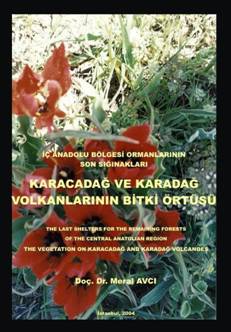 Avci, Meral. 2004. The Last Shelters for the
Remaining Forests of the Central Anatolian Region, The
Vegetation on Karacadag and Karadag volcanoes. Istanbul: Published
by Cantay (In Turkish, also English abstract), 16X24, XI+168 page,
ISBN: 975-7206-99-7.
Avci, Meral. 2004. The Last Shelters for the
Remaining Forests of the Central Anatolian Region, The
Vegetation on Karacadag and Karadag volcanoes. Istanbul: Published
by Cantay (In Turkish, also English abstract), 16X24, XI+168 page,
ISBN: 975-7206-99-7.
The Central Anatolian Region is a vast area
without forests where steppe vegetation is widespread, especially in
comparison to Turkey's coastal regions. Geomorphic processes and other
growth conditions have played an important role in the distribution of
the plant formations in this region.
The
region's climatic characteristics enable tree growth outside of local
natural steppe areas, where human impact as well as natural conditions
have shaped the plant formations. When the whole Central Anatolian
Region is taken into consideration, natural steppe areas, which cover
relatively small parts, have expanded due to human impact
on forests (agriculture, heavy grazing, fires etc.). In this
way, many steppe plants have invaded deforested areas and been
naturalized there. On the other hand, relatively high mountains in this
vast and seemingly treeless region have been the shelter-refuges for the last remaining forests of the Central
Anatolian Region. These mountains include Karacadag
and Karadag volcanoes, which have significant forests that are notable
for their high species richness and endemicity,
reflected in the specific epithets volcano and vulcanicum applied to some of the plant species first collected
from Karadag
Map
Bigfoot subspecies range extents in the continental
U.S.
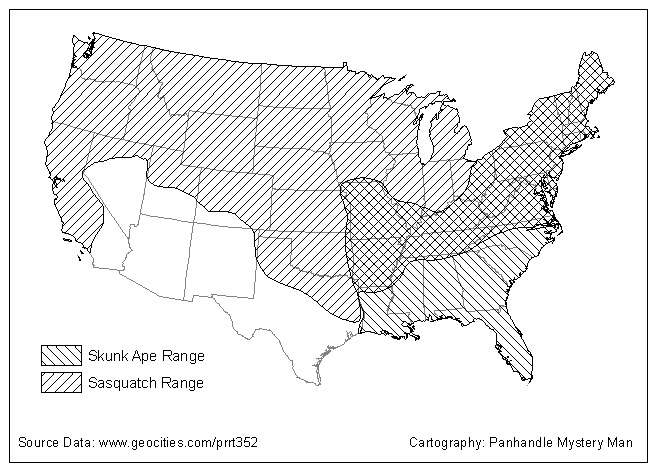
Editor's Note
As always, thanks to everybody who contributed material to this edition, and
a reminder to contribute to the next one. News items, book reviews, or anything
for the Notes sections are always welcome.
Your editor enjoys putting the newsletter together twice a year, but I could
use some help. Specifically, I'm looking for somebody to keep track of member
publications and help assemble and edit the Notes sections. If you can spare
a few hours each fall and winter, let me know. No special skills are necessary.
See you in Denver!
Duane A. Griffin
Editor, The Biogeographer
Bucknell University
Dept. of Geography
Lewisburg, PA 17837 USA
570/577-3374
dgriffin@bucknell.edu
Back to the top.
 The performances and conducting of Serge Koussevitzky
(1874-1951) gave the world its first serious exposure to the double
bass instrument. In 1962, after hearing a New York Town Hall recital
given by Gary Karr, Koussevitzky's widow, Olga, gave Karr the double
bass used by Serge Koussevitzky, reportedly made by Antonio and
Hieronymous Amati in 1611. The Amati brothers were sons of Andrea Amati
who began the famed Amati line of instrument makers in Cremona, Italy,
in the mid to late 1500s. Nicolo Amati (1596-1684), the son of
Hieronymus, was the mentor of Antonio Stradivari.
The performances and conducting of Serge Koussevitzky
(1874-1951) gave the world its first serious exposure to the double
bass instrument. In 1962, after hearing a New York Town Hall recital
given by Gary Karr, Koussevitzky's widow, Olga, gave Karr the double
bass used by Serge Koussevitzky, reportedly made by Antonio and
Hieronymous Amati in 1611. The Amati brothers were sons of Andrea Amati
who began the famed Amati line of instrument makers in Cremona, Italy,
in the mid to late 1500s. Nicolo Amati (1596-1684), the son of
Hieronymus, was the mentor of Antonio Stradivari.
 In conjunction with Dr. Melissa Lenczewski from the Dept.
of Geology and Environmental Geosciences at Northern Illinois
University, we recently initiated a project in New Caledonia examining
the role of the microbial community in vegetation change and structural
associations. We received funding from the American Association for the
Advancement of Science and the National Science Foundation: Program for
Women in International Scientific Collaboration (great program!).
In conjunction with Dr. Melissa Lenczewski from the Dept.
of Geology and Environmental Geosciences at Northern Illinois
University, we recently initiated a project in New Caledonia examining
the role of the microbial community in vegetation change and structural
associations. We received funding from the American Association for the
Advancement of Science and the National Science Foundation: Program for
Women in International Scientific Collaboration (great program!). 





 Avci, Meral. 2004. The Last Shelters for the
Remaining Forests of the Central Anatolian Region, The
Vegetation on Karacadag and Karadag volcanoes. Istanbul: Published
by Cantay (In Turkish, also English abstract), 16X24, XI+168 page,
ISBN: 975-7206-99-7.
Avci, Meral. 2004. The Last Shelters for the
Remaining Forests of the Central Anatolian Region, The
Vegetation on Karacadag and Karadag volcanoes. Istanbul: Published
by Cantay (In Turkish, also English abstract), 16X24, XI+168 page,
ISBN: 975-7206-99-7.